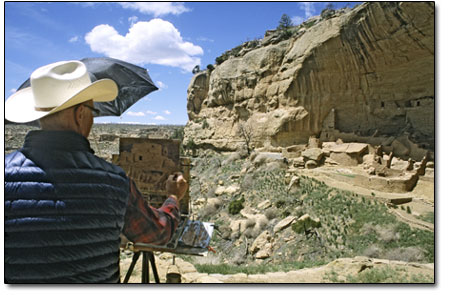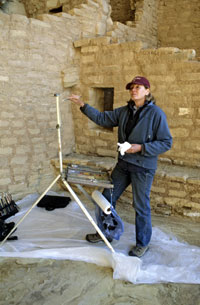|
| ||||
| Mesa Verde inside out
by Katie Clancy
But artists like Veryl Goodnight, owner of the Goodnight Trail in Mancos, are inspiring a transition in how visitors experience Mesa Verde. Her gallery’s most recent show, “The Great Mesa Verde Paint Out 2010,” exhibits nine well-known professional landscape artists who had the opportunity to paint some of the most restricted ruins in Mesa Verde. Last May, the National Park Service invited the group to paint the Long House Ruin and other sites around Wetherill Mesa for three days. Even though Wetherill Mesa is open from Memorial Day to Labor Day for guided tours, the park granted these artists permission to paint the ruins for the first time ever before they opened it to the public for the year. The artists, who live in Colorado, New Mexico, Wyoming and Arizona, included Carole Cooke, Curt Walters, Gregory Hull, Karen Kristin, Marilyn Kroeker, Rosie Sandifer, Susan Matteson and Veryl Goodnight. Jim Wilcox, whose paintings have earned him the title “King of the Grand Canyon,” was also invited. Plein air painting (i.e painting in location) requires a certain amount of patience and comfort, says Marilyn Kroeker. With experience as Mesa Verde’s water color artist in residence in 2009, she understands that staying hydrated and keeping warm are the basics to staying present. A good plein air painter, she says, has the subtle ability to spend time with the changing natural light and is able to capture the essence of the place right down to the temperature of the day. Certainly, the gallery exhibit is unique in the fact that the group had limited access and was comprised of some of the best talent in the nation. But look closely at the paintings, and you will notice details that a digital photograph might never capture. Goodnight´s oil painting “Remembering the Ancients” highlights a black raven perched atop a small kiva. In Ancient Pueblo spirituality, the raven is considered an animal that releases an individual’s healing power; it also acts as a link between the ancestors in the underworld and their living relatives. Gaze into Kroeker’s “Longhouse Remembered” and see tiny seashells blended into the maze, evidence of a recent blessing done in The Long House by a group from the Acoma Pueblo last year. Perhaps it’s these details, captured only by artists who are willing to chase the shifting light of the day, that make this exhibit so powerful. “Being around these artists was truly magical,” explains Andrew Gulliford, the Professor of Southwest Studies at Fort Lewis College who accompanied the group. “Everything slowed down – my heartbeat, breathe, awareness. This kind of painting is about slowly seeing what is out there, focusing on what you want to record, and spending hours with the subject. It’s not a snap decision, it requires a willingness to understand the landscape you are painting.”
If you really take the time to stop and distance yourself from the tour group a bit, you might begin to notice what the Anasazi considered so sacred. Stand still and hear the ravens laughing in the distance, smell the moss along the water spring. The second largest cliff dwelling in Mesa Verde, Long House is said to have been used as a ceremonial site, a place where drumming and dancing conjured spirits. It was also the last dwelling to be deserted when the ancients migrated, and, since it was only excavated in 1959, the last to be discovered by non-natives. People of Puebloan descent are still allowed access to worship there. Officials at Mesa Verde are doing their own work to inspire a new way to experience the park. On Oct. 15, the park will begin an 18- to 24-month construction project for a new visitor and research center. At an estimated cost of $13 million, these brand new buildings will replace the existing research facility that holds more than 3 million artifacts. The new museum will focus on keeping the ancient history alive, while the existing one will be developed to support modern day Native American heritage. The park hopes to attract more visitors by locating the center within sight of Highway 160. “It’s our intention to create access for more people and provide a better service for existing visitors with these improvements,” the Mesa Verde Foundation’s former executive director Paul Balaguer says. The facelift is long overdue, according to Gulliford. “Mesa Verde is under painted and underrepresented in the history of art of the great national parks of the West,” he says. “With this new museum, visitor center and opportunities like ‘The Great Paint Out,’ old stories will live on and new stories will be told. The vision is to build stronger connections with Fort Lewis College and turn it into a learning library, museum and an active ceremonial site.” The park is also building stronger education opportunities with new alternative tour expeditions. Trek down to the “Mugroom” or hike 8 miles with a guide on trails that have just opened to the public for the first time this year. Now you can choose between a crowded group tour that lasts an hour or an all-day expedition that is limited in size. “There is so much potential here in terms of education and access so that our visitors can have a completely different experience,” Park Ranger Adrianne Forster says. The Puebloan people may have left 800 years ago, but “The Great Mesa Verde Paint Out 2010” reminds us of an ancient memory that is still alive. These new programs at Mesa Verde encourage passersby to pause, feel the wind, watch the birds, and start to understand the pace of life 1,400 years ago. • The exhibit is on display at The Goodnight Gallery in downtown Mancos (corner of Main and Grand), through Oct. 10. Five percent of all of the exhibit’s sales will go to the Mesa Verde educational branch. Visit www.goodnighttrailgallery.com for more details.
|



 If you happen to ride one of those mini, Disneyland-inspired trams at Mesa Verde National Park, look up and read on the roof’s outside flap: “Experience your America.” This poses an interesting question for the modern tourist. How do we actually interact with our world heritage sites? Do we speed past the artifacts and archaeological digs, allowing our digital cameras to drink in the landscape instead of seeing them with our own eyes? In this rapid tech age, it might seem like a challenge to fully pause and contemplate the wonder of these ancient monuments.
If you happen to ride one of those mini, Disneyland-inspired trams at Mesa Verde National Park, look up and read on the roof’s outside flap: “Experience your America.” This poses an interesting question for the modern tourist. How do we actually interact with our world heritage sites? Do we speed past the artifacts and archaeological digs, allowing our digital cameras to drink in the landscape instead of seeing them with our own eyes? In this rapid tech age, it might seem like a challenge to fully pause and contemplate the wonder of these ancient monuments.